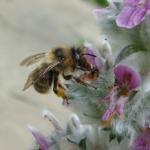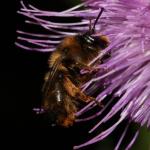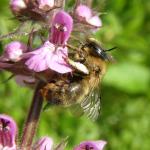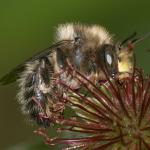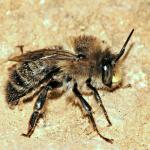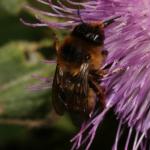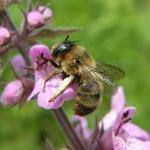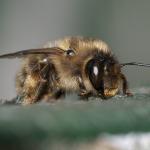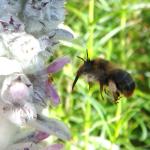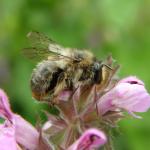Apis dumetorum PANZER 1798
An unusual Anthophora species, which excavates its nest burrows in rotten wood, rather than in the soil. Unusually for Anthophora the mandible is tridentate, with both an inner and outer subapical tooth.
Widely distributed in England, Wales and Scotland (Kircudbrightshire). There are no records from Ireland or the Channel Islands. A Eurasian species, the range extending from western Europe to Kashmir.
The bee is not regarded as being scarce or threatened.
Virtually ubiquitous within its range in lowland Britain, being reported from gardens, woodland, grasslands, moors, heaths and fenlands.
Univoltine; late May to August or early September.
Nest burrows and cells are excavated in rotten wood. A nest generally consists of two or more parallel burrows. Cells are oval in outline and are enlarged sections of the burrow; each cell is lined with compacted wood dust (pers. obs.). A nest is illustrated by Müller, Krebs & Amiet (1997). The winter is passed as a prepupa, not contained within a cocoon.
Bastard balm (Melissa melissophyllum), black horehound (Ballota nigra), bramble (Rubus fruticosus agg.), butterfly-bush (Buddleja davidii), cat-mint (Nepeta cataria), hawkweed (Hieracium), hedge woundwort (Stachys sylvatica), iris (Iris sp. ), knapweed (Centaurea sp.), marsh thistle (Cirsium palustre), marsh woundwort (Stachys palustris), nightshades (Solanum sp.), red dead-nettle (Lamium purpureum), spear thistle (Cirsium vulgare), white dead-nettle (Lamium album), wood sage (Teucrium scorodonia).
Both Coelioxys quadridentata and C. rufescens have been cited as bee cleptoparsites of A. furcata, having been reared from nests of the species (M Edwards, pers. comm., and Richards (1949) respectively).
2006
Proofed: January 2012
Citing this page
Bees, Wasps & Ants Recording Society, 2013. Anthophora retusa. https://www.bwars.com/index.php?q=bee/apidae/anthophora-furcata.[Accessed Date (style 1st January 2013)]


